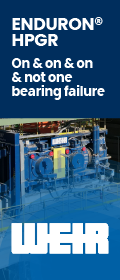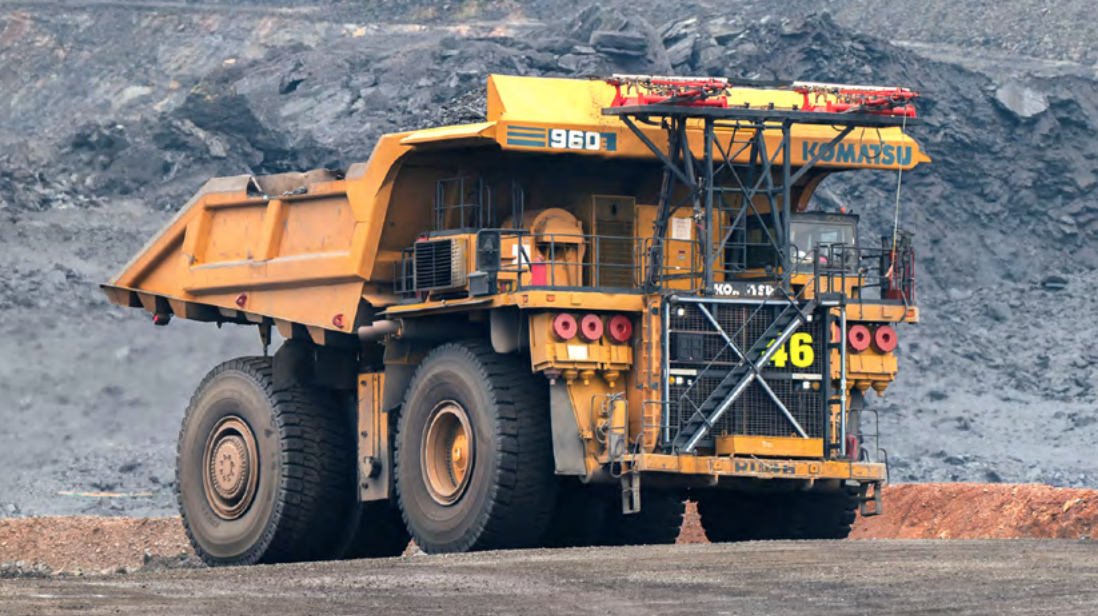First Quantum Minerals Ltd (FQM) last week hosted a media tour to its Trident and Kansanshi copper operations in Zambia which included some updates on technology and mining plans at these sites. With respect to Trident, the major mine is Sentinel, with Enterprise a much smaller nickel focused pit that entered production in June 2024.
Operator FQM Trident Ltd said that the current Sentinel mine fleet includes 48 ultra-class trucks – this is made up of three truck types – Komatsu 860E (255 t), Komatsu 960E (327 t) and Liebherr T 284 (363 t) models.
These are loaded by an extensive shovel fleet including three Caterpillar 7495HR rope shovels, a Komatsu PC8000 (800 t class), plus two Komatsu PC5500 (550 t class) hydraulic shovels, and two large Komatsu LeTourneau L-2350 wheel loaders. The PC8000-11E is notable as it is electric (cable powered). One of the Cat shovels has undergone a major overhaul this year.
All of the truck models operate on the mine’s trolley line which on the tour was cited at comprising 8% of the total haulage routes, with the company actively targeting trolley expansion. The trolley line allows a fully loaded truck speed of 20 km/h with time on the ramp of 3 mins compared to 11 km/h and 5.5 mins not on the line. Diesel use on trolley is 50 l/h equivalent compared to 650 l/h if not connected.
The drill fleet is comprised of seven large production drill rigs (270 mm holes – Caterpillar MD6640), three medium production drill rigs (230 mm holes – Epiroc PV271), four small drill rigs (165 mm holes – Epiroc D65) and two Epiroc DML drill rigs.
Mining capacity will eventually increase to around 60 million bcm of ore and waste mined per annum. The mining fleet was expanded during 2022 and 2023 to support the mining capacity increase. The pit will reach 5.7 km long, 1.5 km wide and 390 m and is being mined in stages, with ore crushed in-pit and conveyed overland to the Sentinel process plant. In 2024, Sentinel saw almost 110 Mt of waste mined and over 51 Mt of copper ore.
Sentinel adopted in-pit crushing as part of the initial design concept in 2012 primarily to reduce haulage costs with ore being crushed in-pit. Three in pit crushers (IPCs) were installed in Stage 1, one IPC in Stage 2 and one in Stage 3 with a total nominal throughput of 25 Mt/y. The existing three IPCs are being upgraded to a similar annual productivity rate. These are thyssenkrupp (FLSmidth) 63-89 gyratory crushers.
The surface conveyors extend across to the plant crushed ore stockpile via a surface transfer bin. During 2022, pit expansion continued eastward and northward in the second pit stage, while vertical
development of both active pit stages continued. In August 2023, the first tonnage from the West Cutback was mined, improving mining efficiency and production.
Waste dumps on the northern and southern perimeters of the pit have been established and a number of water control and management dams have been constructed around the site. Surface power lines extend around the southern, western and northern pit perimeters, connecting to a number of substations powering drills and shovels, and providing power to pit dewatering bores, in-pit sumps and trolley assist lines. A heavy vehicle workshop, incorporating refuelling and wash down facilities, is located on the south side of the pit, adjacent and to the east of the processing plant.
Sentinel’s copper production of 230,792 t for the year ended December 31, 2024 was 8% higher than 2023 due to higher throughput and grades, partially offset by lower recovery. Grades were 4% higher than 2023 as mining activity was focused at the bottom of the high-grade Stage 1 pit, which was inaccessible for a significant portion of 2023 due to the accumulation of water, with 2024 benefiting from an increased focus on strategic planning and management of site-wide water balance and reduction of contact water generation.
Throughput was 4% higher than 2023 with the development of Stage 3 (Western Cut-back) that increased availability of the softer material, improved availability of the primary crushers and improved fragmentation of the ore. Ex-pit mining volumes were a record in 2024 reflecting higher productivities from the load and haul fleet.
In 2025, the focus at Sentinel is on increasing mill throughput with various ongoing initiatives in place to optimise blast fragmentation, maintaining full stockpiles, improved milling rates and flotation recovery. Grades are expected to be lower than 2024, in line with the pit development sequence. Stage 3 will supply a majority of the ore with lower volumes from Stage 1 and Stage 2 compared to prior years. The relocation of in-pit crusher 2 has been planned for the 2025 year, ‘including installation of an innovative rail-driven conveyor system that is expected to result in reduced electricity and maintenance costs.’
This is understood to be the Rail Running Conveyor (RRC) from FLSmidth, where between the head and tail, the belt rests on wheeled carts, which are carried along by their interface with the belt. This lowers friction and thus belt tension, allowing for lighter weight belts and smaller drives. This is notable globally as it will be the first mining-scale RRC reference and will bring 5,000 t/h of copper ore from the mentioned in-pit crusher. Layout for this RRC conveyor has evolved with the mine plan, requiring an extension to a 3.5 km length that includes two horizontal curves with radii of about 1,500m. The curves both eliminate a transfer point and serve as a test bed for the owner’s future long overland conveyor haulages.
The Quantum Electra-Haul™ trolley assist network will be expanded in Stage 2 and Stage 3. Stripping will continue in Stage 4, with ore expected to be available in 2026. Bringing forward production from Stages 3 and 4, along with a balanced and responsible increase in waste stripping, is expected to de-risk future ore supply to achieve an optimal and sustainable balance of grades and volumes during the life of the mine.











